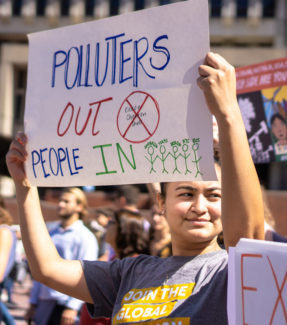Originally published in Huffington Post by Chris D’Angelo
In April 1999, a full-page color advertisement for Carlton cigarettes appeared in the metro section of The New York Times, featuring a woman in a dark blue suit, listening to vinyl and holding a lit cigarette. “It’s the Ultra ultra light,” it read.
It would be the last cigarette ad to run in the influential newspaper, as later that month the Times joined other major print outlets in banning tobacco ads. “We don’t want to expose our readers to advertising that may be dangerous to their health,” a Times spokesperson said then.
But two decades later, apparent loopholes to that policy remain. Now, big tobacco is rebranding itself as the solution to a public health crisis it created and continues to profit from, with ads touting development of “smoke-free,” “better” and “less-risky” alternatives to conventional tobacco products like cigarettes, cigars or chewing tobacco. The ads are everywhere ― including a sizable buy in the Times by tobacco giant Philip Morris International.
The company, best known for its Marlboro brand, pledged in 2016 to eventually stop selling cigarettes. Since September, it has published two digital ads in the Times promoting its efforts to “deliver a smoke-free future.” In one, published last month and titled “We’re Delivering Better Choices,” CEO André Calantzopoulos writes that “better alternatives are at the heart of our commitment to a smoke-free future, and our goal is they will replace cigarettes for good.”
That ad drew the attention of representatives of Corporate Accountability, a corporate watchdog group, who noted the tobacco industry’s long history of deceptive marketing tactics and slammed the NYT for accepting such an ad amid a respiratory disease pandemic. Smoking increases a person’s chance of severe COVID-19 infection and death, according to the Centers for Disease Control and Prevention.
Times spokesperson Eileen Murphy told HuffPost the Philip Morris advertisement is an “advocacy ad” and does not violate the company’s policy because it “does not promote or link to a product.”
“This isn’t new,” Murphy said via email. “We’ve accepted advocacy ads from PMI and from JUUL promoting a smoke free future for some time.” (JUUL, a manufacturer of top-selling vaping products, faced backlash over ads that appeared to target teens and young adults; the company has since reportedly described such advertising as “intended for adults” and “short-lived.”)
The recent Philip Morris ads don’t name or directly link to any of the company’s products, but they are clearly meant to pitch the IQOS, a device that looks much like an e-cigarette and heats leaf tobacco without burning it, allowing it to deliver nicotine in aerosol form rather than smoke. In fact, the ad featuring Calantzopoulos links to a page on Philip Morris’ website that includes a link to the company’s 2020 proxy statement, which mentions IQOS multiple times.
Altria Group Inc., the parent company of Philip Morris USA, sells the IQOS in the United States through an exclusive licensing agreement with Philip Morris International. PMI, spun off from Altria in 2008, sells Marlboro, IQOS and other Philip Morris brands globally.
The IQOS is marketed as a “better alternative” to smoking, but the device has not been scientifically shown to reduce smoking-related health risks overall or to help smokers quit. In July, the U.S. Food and Drug Administration concluded that IQOS does reduce a person’s exposure to harmful chemicals, but denied Philip Morris’ application to market it as a product that reduces the risk of tobacco-related disease.
“Even with this action, these products are not safe nor ‘FDA approved,’” the regulator noted.
Philip Morris’ advertising could be read as suggesting otherwise. In the Times ad, Calantzopoulos touts that “better alternatives, backed by science, are real, and they have the potential to deliver a huge public health opportunity.”
Smoke Screen
It’s hard to argue the ads aren’t meant to help Phillip Morris sell its newest products. Search on Google for the company name and “smoke free” and you’ll get a slew of information about IQOS.
“It’s an invitation to learn more, which is a marketing tactic used all the time,” said Jesse Bragg, media director of Corporate Accountability. “If McDonald’s ran an ad that had their logo and language about antibiotics in their supply chain, the objective of that ad is still selling burgers and fries.”
Robert Jackler, a Stanford University professor and tobacco industry expert, called the ads “hypocritical and gratuitous” and said the Times should have never run them.
“This is part of a campaign that the New York Times should not be complicit with,” said Jackler, the co-founder and director of Stanford’s Research Into the Impact of Tobacco Advertising. “I am deeply disappointed that The New York Times chose to run paid propaganda from a tobacco company.”
In a lengthy email statement, Philip Morris spokesperson Corey Henry said that the company’s goal is “to switch those of the world’s 1 billion smokers who would otherwise continue to smoke to better alternatives as quickly as possible,” and that it is “disrupting” its business in order to make it happen.
“We are doing everything we can to move as fast as we can,” Henry said. “We are the only tobacco company that has made this commitment.
Among other things, Henry noted that IQOS is now available in 61 international markets; that 98% of the company’s research and development dollars in 2019 ― some $460 million ― was spent on “smoke-free products”; and that in the past five years, approximately 11.7 million people globally have stopped smoking and switched to IQOS.
In 2017, Philip Morris launched the “Foundation for a Smoke-Free World,” which it claims is an “independent” nonprofit whose mission is “to end smoking in this generation.” The company has pledged to spend $1 billion over 12 years on the project.
But anti-smoking groups and public health advocates see the foundation as little more than the tobacco giant’s latest attempt to burnish its image. The World Health Organization, which prohibits tobacco companies from attending international tobacco treaty negotiations, has refused to partner with the foundation, citing “a number of clear conflicts of interest involved with a tobacco company funding a purported health foundation.” WHO called on governments and the public health community writ large to follow its lead.
The American Cancer Society also dismissed the foundation as “a continuation of a decades-long effort to paint over tobacco’s role in spreading death and misery around the globe.”
“This attempt by Philip Morris International to paint itself as a public health partner is manipulative and dangerous,” the cancer society said when the foundation launched in September 2017. “It is a new twist out of the tobacco industry’s deadly playbook, but nobody should be fooled.”
Jackler said the company’s ongoing “smoke-free” campaign, which he and his team at Stanford closely track, seeks to protect revenues amid declining cigarette sales, make smoking socially acceptable and circumvent regulations that restrict where people can smoke. If Philip Morris was serious about achieving a smoke-free future, it would invest in developing cessation products to help people quit, he said ― but that’s not a profitable business model.
“Their products kill millions of people around the world every year,” Jackler said. “If they really were a noble protector of health, they would stop selling Marlboro.”
“The dark secret is that they are selling addiction and continued addiction.”
Last year, “smoke-free products” accounted for 19% of Philip Morris’ nearly $30 billion in net global revenue and 8% of its shipped products. Those percentages are up from 3% of revenue and 1% of product volume in 2016, according to company data.
Although the growth of these products has been rapid, more than three-quarters of the company’s global revenue in 2019 came from conventional cigarettes. And Philip Morris continues to market conventional cigarettes around the globe and fight stricter regulations on tobacco.
Much like the oil and gas industry characterizes natural gas as a “bridge fuel” to achieve a renewable energy future, Philip Morris says the “combustible category” of tobacco ― cigarettes ― must remain part of the nicotine mix.
“It is the fuel, both financially and as a matter of maintaining relationships with adults who smoke, for the engine of our smoke-free transformation,” Henry said.
The New Industry ‘Science’
Messaging about reducing tobacco-related health risks is nothing new for the industry.
Beginning in the 1960s, so-called light and ultra light cigarettes were tobacco companies’ answer to public concern about the impacts of smoking. Later came marketing campaigns promoting brands low in tar and nicotine. Science would ultimately prove that such products were no less hazardous than smoking regular cigarettes, and the U.S. passed a law in 2009 banning tobacco companies from using terms like “light” and “mild” in their advertising.
IQOS and similar heated tobacco products are the light cigarettes of today, said Matt Myers, president of Campaign for Tobacco-Free Kids.
“I’ve been working on tobacco issues for 40 years,” Myers said. “During that period of time, Philip Morris has on multiple occasions conducted campaigns to assert that they care about consumers’ health and that they are a responsible company that is a critical part of the solution. In the past, every one of those campaigns has in fact been nothing more than a disguise to allow them to continue marketing Marlboro.”
There is no reason to believe this time is any different, Myers said. And the company’s actions overseas, which include aggressively marketing its existing cigarette brands, launching a new one in Indonesia and rolling out new flavors like Marlboro Splash Mega Purple, further undermine those claims.
“What they are counting on is people not noticing what else they’re doing,” Myers said.
Unlike Jackler, Myers doesn’t blame the Times for running the Philip Morris ads. It is often hard to differentiate between an industry ad aimed at pitching a new product and one that promotes a company as a whole or participates in a public debate, he said. As Myers sees it, Philip Morris’s target audience in this particular case is not consumers, but policymakers and regulators.
“It is designed in large part to give visibility to their claim that they are a legitimate stakeholder who deserves to be at the table, at a point in time where most governments no longer see the tobacco companies as legitimate stakeholders,” Myers said.
Henry, of Philip Morris, acknowledged that the ads are part of its effort “to inform key opinion leaders of our mission to achieve a science-based smoke-free future” and said “governments and public authorities have a big role to play.”
‘A Better Tomorrow’
Other tobacco industry players have taken a similar tact. In March, British American Tobacco, whose defunct U.S. subsidiary Brown & Williamson Tobacco manufactured Carlton cigarettes, unveiled a new logo, retiring its signature tobacco leaf, and adding the slogan “a better tomorrow.”
The company notes on its website that its “purpose has evolved as we aim to reduce the health impact of our business through offering a greater choice of enjoyable and less risky products for our consumers.”
Both companies are leading the charge on heated tobacco technology. Philip Morris has sought to corner the market through a sophisticated advertising campaign that “with the sole exception of the change/switch theme … faithfully recapitulate the techniques used by the tobacco industry during the 20th century,” Jackler and other Stanford researchers concluded in a lengthy study of IQOS released in February.
The campaign has included enlisting celebrities and social media influencers, sponsoring parties and festivals, and partnering with bars and restaurants to establish “IQOS friendly” spaces where the devices are permitted but cigarettes are not. Last year, Philip Morris suspended a social media campaign for IQOS after a Reuters investigation found that it had violated its own policy against using models and online personalities younger than 25 to promote the device.
Meanwhile, Philip Morris has turned to major media outlets to paint itself as a champion of science. In 2019, it struck a $6 million deal with Vice News for the company to produce sponsored content promoting its products. In a full-page ad in The Washington Post in September, its CEO slammed unnamed public health organizations for “allowing disinformation to supplant legitimate science” and called for “science, not rhetoric, to inform policies and regulations.”
And in a similar September ad in the Times, Moira Gilchrist, Philip Morris’ vice president of strategic and scientific communications, lamented how “the absence of accurate scientific information creates the conditions for ‘junk’ or bad science to gain prominence.”
“We have great challenges ahead of us ― climate change and the novel coronavirus pandemic, to name just two ― so ensuring science takes precedence over ideology, politics, and unsubstantiated beliefs is of pressing importance,” Gilchrist wrote.
The statement is astonishing to anyone who has followed the tobacco industry’s decadeslong campaign to undermine the science about the health risks of smoking ― a scheme that seems only to rival the oil industry’s cover-up of global climate change. The two industries have worked collaboratively for half a century, sharing marketing and advertising strategies, research institutes, PR firms and even scientists, according to documents the Washington-based Center for International Environmental Law released in 2016.
“When you don’t have the scientific argument, when responsible scientific consensus is opposed to your business, you manufacture doubt,” said Jackler. “You manufacture doubt by commissioning scientists to find alternative facts … And then you of course smirch the legitimate scientists by calling it ‘junk science.’”



